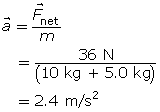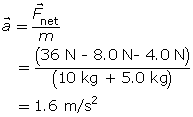Module 3—Effects of Force on Velocity
 Read
Read
Read pages 159 to 161 of your textbook. Look for significant differences between Newton’s third law and the two laws you previously studied.
Self-Check
SC 1. Complete the following sentence by filling in the blank. In Newton’s third law, the two forces not only act in different directions, they also act on different __________.
 Self-Check Answer
Self-Check Answer
SC 1. Complete the following sentence by filling in the blank. In Newton’s third law, the two forces not only act in different directions, they also act on different objects.
 Read
Read
What happens when forces are exerted between objects that are separated and do not touch each other? Read “Action-Reaction Forces Acting on Objects in Contact” and “Action-Reaction Forces Acting on Objects Not in Contact” on pages 161 to 163 of your textbook. Look for significant differences between the two situations.
 Self-Check
Self-Check
SC 2. What are two situations where action-reaction forces act on objects that are not in contact?
 Self-Check Answer
Self-Check Answer
SC 2. Other answers are possible, but two situations where action-reaction forces act on objects that are not in contact include the following:
- Earth’s gravity pulling on an object, and the object pulling on Earth
- a magnet pulling on an iron object, and the iron object pulling on the magnet
 Read
Read
Have you ever moved an object without touching it by pushing on other objects that were in contact with it? How are Newton’s laws involved in what happens? Read “Applying Newton’s Third Law to Situations Involving Frictionless Surfaces” and “Applying Newton’s Third Law to Situations Involving Friction” on pages 164 to165 of your textbook to see how the calculations are done. You will learn more in Module 3: Lesson 4 about the free-body diagrams used in these examples.
 Self-Check
Self-Check
SC 3.
- What are three forces exerted on box B in “Example 3.12” on page 164 of your textbook?
- What are three forces exerted on box B in “Example 3.13” on page 165 of your textbook?
 Self-Check Answers
Self-Check Answers
SC 3.
- Three forces exerted on box B in “Example 3.12” are the force of gravity, a force from box A, and a force from box C. (Another force is the normal force holding it up.)
- Three forces exerted on box B in “Example 3.13” are the force of gravity, a force from box A, and the force of friction. (Another force is the normal force holding it up.)
 Read
Read
What are the action-reaction pairs in propeller aircraft and rockets? Read pages 166 and 167 of your textbook. Look for significant differences between propeller aircraft and rockets.
 Self-Check
Self-Check
SC 4.
- What is the action-reaction pair that provides thrust in propeller aircraft?
- What is the action-reaction pair that provides thrust in rockets?
 Self-Check Answers
Self-Check Answers
SC 4.
- The action-reaction pair that provides thrust in propeller aircraft is the propeller pushing the air backwards and the air pushing the propeller forward.
- The action-reaction pair that provides thrust in rockets is the push of the exhaust gas backwards by the rocket engine and the push on the rocket engine by the exhaust gas.
 Try This
Try This
Re-open the Momentum Conservation simulation, if necessary. Then complete the following questions.
TR 1. Two hockey players are standing at centre ice. One player with a mass of 75.0 kg pushes the other player with a mass of 95.0 kg. Which player will move away with a greater acceleration? Why? Verify your answer using the applet.
 Module 3: Lesson 2 Assignment
Module 3: Lesson 2 Assignment
Remember to submit the answers to TR 2 and TR 3 to your teacher as part of your Module 3: Lesson 2 Assignment.
TR 2. Two basketball players run into each other. Player 1, with a mass of 55.0 kg, experiences a –15.6 m/s2 acceleration. If player 2 has a mass of 48.5 kg, what acceleration did she experience immediately following the collision?
TR 3. Complete the following table. The first row has been completed as an example.
Action |
Action Force |
Reaction Force |
A bullet is fired from a gun by the expanding gases. |
expanding gases pushing on the bullet |
bullet pushing back on the expanding gases |
A volleyball is served. |
player's hands exerting a forward force on the ball |
|
| The Moon orbits Earth. | moonward pull of the Moon acting on Earth | |
A firewoman opens the fire hose, and water sprays forward. |
||
A sprinter’s shoe hits the ground. |
 Self-Check
Self-Check
SC 5. Solve problem 8 of “3.4 Check and Reflect” on page 168 of the textbook.
 Self-Check Answers
Self-Check Answers
SC 5.
8. (a)
Given
mX = 10 kg mY = 5.0 kg ![]() = 36 N [right]
= 36 N [right]
Required
the action-reaction forces of the blocks on each other (![]() and
and ![]() )
)
Analysis and Solution
Only the horizontal forces need to be considered. Let the direction to the right be positive. Calculate the acceleration of the two-block system. Then calculate the force necessary to accelerate block Y, which will be ![]() .
.


The positive value indicates the force is to the right. By Newton’s third law, the force of block Y on block X will be equal in magnitude but in the opposite direction or left.
Paraphrase
The force of block X on block Y is 12 N [right], and the force of block Y on block X is 12 N [left].
8.(b)
Given
mX = 10 kg mY = 5.0 kg ![]() = 36 N [right]
= 36 N [right] ![]() = 8.0 N
= 8.0 N
![]() = 4.0 N
= 4.0 N
Required
the action-reaction forces of the blocks on each other (![]() and
and ![]() )
)
Analysis and Solution
Only the horizontal forces need to be considered. The direction of the forces of friction will be left because that is opposite to the direction of travel. Calculate the acceleration of the two-block system. Then calculate the net force that accelerates block Y.


The positive value indicates the force is to the right. However, block X must exert an extra 4.0 N to overcome the force of friction on block Y. Therefore, the force of block X on block Y will be (8.0 N + 4.0 N) or 12 N. By Newton’s third law, the force of block Y on block X will be equal in magnitude but in the opposite direction or left.
Paraphrase
The force of block X on block Y is 12 N [right], and the force of block Y on block X is 12 N [left].
 Watch and Listen
Watch and Listen
Watch the video titled Newton’s Laws Part 4, which explains the significance of Newton’s laws.
 Module 3: Lesson 2 Assignment
Module 3: Lesson 2 Assignment
Remember to submit the answers to TR 4, TR 5, and TR 6 to your teacher as part of your Module 3: Lesson 2 Assignment.